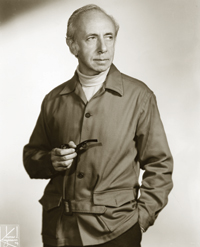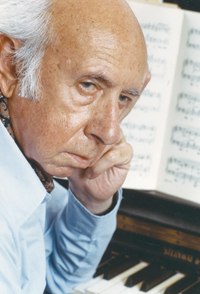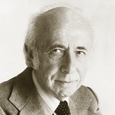 Morton Gould was a versatile and prolific composer – a crossover musician before the term was invented. He was born in Richmond Hill, New York in 1913 of Austrian and Russian parents and died in 1995 after attending a concert of his music performed by the United States Military Academy Band (West Point) at the Disney Institute in Orlando where he was the first resident guest composer/conductor. Gould successfully integrated jazz, blues, gospel, country-and-western, patriotic and folk elements into his compositions. Like Leonard Bernstein and André Previn, he composed music that was a mix of popular and classical styles. Gould wrote music for Broadway shows, films, television and ballet and received numerous commissions for pieces from organizations including the National Symphony Orchestra, Library of Congress. Chamber Music Society of Lincoln Center, American Ballet Theatre and the New York City Ballet. New York Times music critic Bernard Holland wrote the following about Gould’s music:
Morton Gould was a versatile and prolific composer – a crossover musician before the term was invented. He was born in Richmond Hill, New York in 1913 of Austrian and Russian parents and died in 1995 after attending a concert of his music performed by the United States Military Academy Band (West Point) at the Disney Institute in Orlando where he was the first resident guest composer/conductor. Gould successfully integrated jazz, blues, gospel, country-and-western, patriotic and folk elements into his compositions. Like Leonard Bernstein and André Previn, he composed music that was a mix of popular and classical styles. Gould wrote music for Broadway shows, films, television and ballet and received numerous commissions for pieces from organizations including the National Symphony Orchestra, Library of Congress. Chamber Music Society of Lincoln Center, American Ballet Theatre and the New York City Ballet. New York Times music critic Bernard Holland wrote the following about Gould’s music:
Indeed, Mr. Gould’s music matched his life style: rhythmically profuse, filled with dynamic energy, and not afraid to incorporate American culture even in its most blaring forms. Yet there is a sophisticated use of counterpoint and meter, and an ease in the handling of such 20th-century procedures as Serialism.1
Gould’s Life and Career
Gould began playing piano and composing at age four. By the time he was eight, he was performing regularly on radio broadcasts. During the Great Depression he played piano in movie and vaudeville theaters and in 1932 was appointed a staff pianist at Radio City Music Hall in New York City. Two years later (1934) Gould landed a conducting job at radio station WOR Mutual, New York, conducting popular music.
While he was working on radio and performing as a professional pianist, Gould was also composing symphonic works, among them his Concerto for Piano and Orchestra (1934) and Foster Gallery (1939), based on Stephen Foster melodies (Fritz Reiner suggested that Gould write this piece). In 1936 Leopold Stokowski and the Philadelphia Orchestra premiered his Chorale and Fugue in Jazz. During the 1940s Gould composed three symphonies and music for film, stage and ballet and also collaborated with Betty Comden and Adolph Green to write Billion Dollar Baby, a Broadway musical, and created scores for Jerome Robbins’ ballet Interplay (1945) and Agnes de Mille’s Fall River Legend (1947). Gould wrote concertos for two close friends in the 1950s: Tap Dance Concerto (1952) for Danny Daniels and Derivations for Solo Clarinet and Dance Band for Benny Goodman (1955). He also composed two other unusual pieces, The Jogger and the Dinosaur for a rapper/narrator and Hosedown for a fire department. In the 1960s and 70s Gould expanded his compositional efforts to include music for television (including scores for World War I and Holocaust which starred Meryl Streep).
As a conductor, Gould worked with all of America’s major orchestras as well as internationally in Australia, Canada, Europe, Japan and Mexico. He also made recordings of his own music and works by Copland, Myaskovsky, Nielsen, Rimsky-Korsakov, Shostakovich and others. In 1966 his recording of Charles Ives’ Symphony No. 1 with the Chicago Symphony Orchestra won a Grammy Award and contributed to the reawakening of interest in Ives and his music. He also received the 1995 Pulitzer Prize in Music for his thirty-minute work, Stringmusic (1993), that was commissioned by the National Symphony Orchestra to honor their retiring music director, Mstislav Rostropovich.
Gould served as president of ASCAP from 1986 to 1994. Following his death, ASCAP changed the name of its annual Young Composers Award Program to the ASCAP Foundation Morton Gould Young Composer Award in recognition of his encouragement, commitment and support of young composers. Gould was elected to the American Academy and Institute of Arts and Letters in 1986; was recognized by the Kennedy Center for his lifetime contribution to American culture in 1994; and received a Grammy Lifetime Achievement Award in 2005.
Gould and Wind Bands
His first exposure to bands was listening and watching an American Legion Band practice across the street from his Long Island home and police and firemen bands in Memorial Day parades. In 1978 he recalled that, “These bands often played out-of-tune and their sound was certainly not the most prepossessing thing I ever heard.”2
The Mills Music Publishing Company, after signing Gould as a composer, suggested that he write some band music. Gould recalled turning up his nose at this suggestion.
Why do I want to write for band? I’m having enough problems with the professional orchestras.… Why should I have to deal with music for kids? But the general manager of Mills Music, [Mack] Stark, convinced me to write a work and try it out with the University of Michigan Band. Dr. Revelli said he would love to have me as a guest conductor to do part of a concert and introduce my Cowboy Overture (1941). I remember saying to Stark: “[Mack], why am I doing this?” and he said, “You’re going to be surprised, very surprised.”3
The Michigan Band’s performance of his piece overwhelmed him, and he was impressed by the band’s sensitive and expressive performance. This experience ignited Gould’s life-long interest in bands. During his career Gould composed over 45 works for young and mature wind groups including wind ensemble, concert band, marching band, jazz band and orchestra woodwind, brass and percussion sections.
During World War II Gould wrote patriotic pieces such as American Salute and numerous marches: Buck Private, March for Yanks, Bombs Away and the March of the Leathernecks for the U.S. Marine Corps. The latter march was given its premiere performance by the U.S. Marine Band in June 1946. Gould’s American Salute (1942) is an orchestra suite based on the familiar American melody “When Johnny Comes Marching Home.” It was written in response to a request by a government radio producer “who wanted a salute to America.” Philip Lang, a leading band arranger/transcriber of the day, created the band version of the piece. The following year (1943) Gould composed a short Fanfare for Freedom for conductor Eugene Goosens and the Cincinnati Symphony. It was one of a series of fanfares commissioned by the orchestra to start their World War II concerts. The final work of Gould’s World War II compositional period is Yankee Doodle (Setting for Band) (1945). It is a virtuosic, semi-serious piece based on the popular American tune.
In 1946 Edwin Franko Goldman, conductor of the famous Goldman Band, asked Gould to write a piece. He responded with Ballad for Band, a one- movement, ten-minute work in three parts. The opening and closing sections are slow and lyrical; the middle section, fast and spirited. Gould provided the following comment about the piece:
The romanticism of folk music is strongly evident in Ballad for Band. It also captures the spirit of popular music and dance forms. The beauty of the melody can hide the complexities of theme exchanges within the sections of the band. Antecedent-consequent phrases play off each other and build tension. Accents, syncopation, and lively rhythmic patterns complement the lush harmonies of the chord structures.4
 In 1951 Major Francis E. Resta, commanding office and conductor of the United States Military Band and Director of Music at the United States Military Academy, invited Gould to write a piece for the West Point Sesquicentennial Celebration (there was no commission fee attached to this request). Gould created a masterpiece for the occasion, his Symphony for Band (subtitled the West Point Symphony). The West Point Band, with the composer conducting, premiered the work on April 13, 1952. Gould states that he wrote the Symphony not only to honor the soldiers of West Point but also for “all who have suffered needless loss due to mankind’s inhumanity, to war, and to all the things that cause war.” Gould’s knowledge and command of the resources of the modern band are evident throughout the work. The work’s melodic material recalls things associated with military life, including march-like tunes and bugle calls. “Epitaphs,” the work’s first movement, is lyrical and dramatic. It features sonorous brass statements and contemplative woodwind passages. At one point in this movement, Gould employs an instrument of his own invention – a marching machine, designed to simulate the sound of marching soldiers. “Marches,” the work’s second movement, is lusty and cheerful. Gould offers the following insight into this movement.
In 1951 Major Francis E. Resta, commanding office and conductor of the United States Military Band and Director of Music at the United States Military Academy, invited Gould to write a piece for the West Point Sesquicentennial Celebration (there was no commission fee attached to this request). Gould created a masterpiece for the occasion, his Symphony for Band (subtitled the West Point Symphony). The West Point Band, with the composer conducting, premiered the work on April 13, 1952. Gould states that he wrote the Symphony not only to honor the soldiers of West Point but also for “all who have suffered needless loss due to mankind’s inhumanity, to war, and to all the things that cause war.” Gould’s knowledge and command of the resources of the modern band are evident throughout the work. The work’s melodic material recalls things associated with military life, including march-like tunes and bugle calls. “Epitaphs,” the work’s first movement, is lyrical and dramatic. It features sonorous brass statements and contemplative woodwind passages. At one point in this movement, Gould employs an instrument of his own invention – a marching machine, designed to simulate the sound of marching soldiers. “Marches,” the work’s second movement, is lusty and cheerful. Gould offers the following insight into this movement.
The texture is a stylization of marching tunes that parades past in an array of embellishments and rhythmic variants. At one point there is a simulation of a Fife and Drum Corps which, incidentally, was the instrumentation of the original West Point Band. After a brief transformed restatement of the themes in the first movement, the work finishes in a virtuoso Coda of martial fanfares and flourishes.5
As noted above, Gould composed Derivations in 1955 for Benny Goodman and his jazz combo. It is a mini-concerto in four movements (“Warm-up,” “Contrapuntal Blues,” “Rag,” and “Ride-Out”). Scored for solo clarinet, four saxophones, two trumpets, bass, piano and two percussionists, Gould used the players mostly as soloists or in pairs. Steve Schwartz., a reviewer for ClassicalCDReview states that “To me, (this is) one of the best works by an American, it makes me think of Stravinsky with a jazz beat.”6
In 1955 Edwin Franko Goldman requested another work from Gould – this time for the American Bandmasters Association. The 1956 ABA National Convention was scheduled to be held in Santa Fe, so Gould composed a piece to reflect the area’s Spanish, Mexican and Western-American cultures. Santa Fe Saga has four clearly defined sections (“Rio Grande,” Round-up,” “Wagon Train” and “Fiesta),” that are played without pause.
In 1958, the United States-Canadian regional power authorities commissioned Gould to write a piece to celebrate the opening of the St. Lawrence Seaway Project. The commissioners wanted a “grand and epic” piece. Gould’s four-movement, ten-minute work, St. Lawrence Suite, is a reflective and lyrical piece. Half of the movements feature two “intertwining/dueling” trumpets, located antiphonally at the left and right of the ensemble; some see this as the two countries calling to each other. The two are joined together in the work’s final movement, “Ceremonial March.” The St. Lawrence Suite “…is a perfect example of Gould’s sophistication at work below the surface of something superficially simple. The tune could be featured in a John Williams score, but the sliding harmonies and shifting accompaniment imply more than simple heroics.”7 This piece has the distinction of being the only original wind band work ever nominated for a Grammy Award for composition.
Perhaps Gould’s most unusual work for band is his Formations Suite written in 1964 for the University of Florida Marching Band. It consists of eight short movements, each intended to be performed by the band in different marching formations (1. March On, 2. Rally, 3. Twirling Blues, 4.Strut, 5. Slink, 6. Waltzing Alumni, 7. Alma Mater, 8. March Off). Gould brought freshness and originality to the conventions of marching band music in this work. Elliot Feld and his ballet company, Ballet Tech, used Formation Suite for their 1978 ballet, Half-time.
Gould’s American Ballads, Settings of American Tunes for Orchestra, is a 1976 Bicentennial commission by the Queens Symphony Orchestra. The composer states that,
It seemed logical to continue the paraphrases and instrumental comment on our musical heritage that shaped my career through the years….I purposely selected American “chestnuts” because of obvious immediacy and familiarity and therefore a challenge to hopefully enhance them in orchestra transformation.8
Gould selected one of the suite’s patriotic settings, “The Girl I Left Behind Me,” and created the Saratoga Quickstep for band. Gould chose the title because the song was used during the Revolutionary War to taunt General “Gentleman Johnny” Burgoyne on his defeat at Saratoga.
Remembrance Day, Soliloquy for a Passing Century was Gould’s final work for wind band/ensemble. The nine-minute work was commissioned by the University of Connecticut for the opening of the Thomas J. Dodd Research Center for International Human Rights. The University of Connecticut Wind Ensemble with Jeffrey Renshaw, conductor, premiered it on October 15, 1995 at a special concert in Carnegie Hall honoring Gould’s contribution to the band repertoire (“A Celebration of Morton Gould”). In a lengthy foreword to the score, Gould described the piece.
Remembrance Day opens with a prologue evoking a distant nostalgic lullaby. As it fades, a sudden loud chime combines with high clarinets in an anguished sequence that cries out a musical pattern establishing and shaping the body of the work. The music alternates between elegiac thematic references and the pulsings and accents of chimes and tolling bells. A slight pause – then subdued but menacing sounds from muted trombones, tuba and percussion. Over this is a variant of the clarinet initial “cry of anguish” – but this time in quiet grief – turning into a funeral cortege. The cortege proceeds to chants and responses that grow in intensity, changing to hymn-like swells and embellishments. A sudden explosive interruption, brutal and violent – the previous menacing muted trombone motif now unleashed. This leads to a full blown and affirmative chorale. Following this climax the work winds down, diminishing in intensity. There are passing references to what was heard before.
Now comes a last variation on the chant, and a “pianissimo” echo variant in muted trumpets and then woodwinds of the opening lullaby – some final pulsings – a few timpani beats – silence.
Gould concludes:
I…hope that our children’s children, and their children in the 21st century, will live in a world of Peace and Compassion, wondering why we inmates of the 20th Century Asylum spent most of the time destroying each other, while fervently believing in the Divinity of Humankind.9
Even though Remembrance Day is scored for wind ensemble, Gould made certain parts optional so the piece can also be performed by an orchestra woodwind, brass and percussion section.
Morton Gould was a talented pianist and conductor, but composing was his lifeblood. “Although I have done many things in my life…what is fundamental is my being a composer.” Gould embraced everything around him. He stated, “I have always been and am still stimulated by the vernacular, by the sound of spirituals, jazz and the like. Although I might venture into more complicated abstractions, there is always present in one form or another at least the residue of those elements.”10
Band directors in 2013 can celebrate the 100th anniversary of this truly American composer’s birth by programming some of his inspiring and enjoyable music.
Endnotes
1 Bernard Holland, “Morton Gould, Composer and Conductor, Dies at 82, “New York Times online edition: http://www.nytimes.com/1996/02/22/ny region/morton-gould-composer-and-con ductor-dies-at-82.html, February 22, 1996
2Jeffrey Renshaw, “A Tribute to an American Musical Icon,” The Instrumentalist, July 1996, p. 19.
3”American Salute,” The Instrumentalist, October 1978, p. 19.
4Wind Program Notes–G–Wind Band Home Page: http://www.windband.org/
foothill/pgm_note/notes_g.htm#Gould .
5Program notes, U.S. Marine Band CD-28, “Morton Gould: An American Salute,” 2012, p. 20.
6Steve Schwarz, ClassicalCDReview: University of Kansas Wind Ensemble, Naxos 8.57269 TT, “Morton GOULD ‘Derivations,’” 2011, http://www.classicalcdreview.com/8572629.html
7Nick Barnard, Review in Music Web International: http://www.music-web international.com/classrev/2011/July11/Gould_derivations_8572629.htm
8(G. Schirmer, Inc, Programme Note: http://www.schirmer.com/default.aspx?tabId=2420&State_2874=2&workId_2874=28261
9Jeffrey Renshaw, “A Tribute to an American Icon,” The Instrumentalist, July 1996, p. 18.
10Bernard Holland, “Morton Gould, Composer and Conductor, Dies at 82,” New York Times online edition: http://www.nytimes.com/1996/02/22/ny region/morton-gould-composer-and-conductor-dies-at-82.html, February 22, 1996.






